Dive Brief:
- Comparable sales in Q2 were up across all TJX Cos. banners and up 6% overall as the off-price retailer once again benefited from the industry’s excess inventory.
- “[A]ll indicators are there will be a continued additional supply at least over the next six to 12 months,” CEO and President Ernie Herrman told analysts Wednesday.
- Aside from the excess stock from brands and retailers, TJX’s assortment has also benefited from the demise of Bed Bath & Beyond’s physical retail business. Hermann said the home goods retailer’s fate “creates additional supply of buying opportunities.”
Dive Insight:
So far in 2023, TJX executives have described the availability of products out there for its buyers to snap as “phenomenal” — a word used in every one of the company’s earnings calls this year — and “outstanding.”
For the off-pricer, others’ pain is its gain. Retailers and especially individual brands have been working through inventory overages as they try to navigate choppy demand, with consumers braced against inflation and gloomy economic moods.
For nearly 50 years, the company’s T.J. Maxx banner has functioned as a channel for others’ excess inventory. What retailers can’t sell at full-price becomes a buying opportunity for T.J. Maxx and its sister banners, including Marshalls and Home Goods.
The range of product on the market now has been a particular boom for TJX, which sells across consumer demographics and income levels with what it calls a “good, better, best” approach to product procurement and sales.
“If you look at most retailers around us, very few do that,” Herrman said. “They're zeroing in on certain demographic segments, which could include age or fashion looks or different price levels. And we don't do that. And I think that will continue to be a benefit to us over the next five to 10 years.”
The strategy means it can attract a wide array of product and give brands some confidence that their value with customers won’t be diluted by appearing in a TJX store.
It also helps smooth out any bits of scarcity within categories in a given quarter. “We still have those pockets of opportunity where we don't have the mix balanced exactly the way we want it to be,” Hermann noted while also pointing to the company’s 6% growth in comparable sales.
The company’s supply base is enormous and critical to its success, with more than 1,200 merchants in its buying organization. “This vast network of changing vendors, which numbered approximately 21,000 over the last year, is the reason why we are so confident that there will always be more than enough inventory in the marketplace for us to buy,” Herrman said.
Along with retailers looking to clear inventory, those merchants have also taken advantage of struggling rivals in the home goods space. Hermann said TJX has taken market share from Bed Bath & Beyond over the years as well as more recently struggling online retailers in the market.
Bed Bath & Beyond’s suppliers have been turning to TJX and its Home Goods banner — along with other rivals, including Overtstock, which recently acquired the Bed Bath & Beyond name.
“At the retail level, customers need another place to shop,” Herrman said of Bed Bath & Beyond. “But for our merchants, they get to take advantage of additional supplies. And we mean even more now to certain vendors, because now they have less places for them to sell their goods.”














